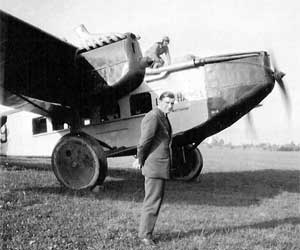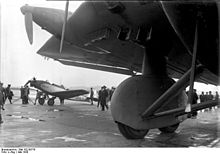
Junkers Flugzeug- und Motorenwerke AG more commonly Junkers, was a major German aircraft and aircraft engine manufacturer. It was founded in Dessau, Germany, in 1895 by Hugo Junkers, initially manufacturing boilers and radiators. During World War I and following the war, the company became famous for its pioneering all-metal aircraft. During World War II the company produced the German air force's planes, as well as piston and jet aircraft engines, albeit in the absence of its founder who had been removed by the Nazis in 1934.

The Junkers Ju 52/3m is a transport aircraft that was designed and manufactured by German aviation company Junkers. First introduced during 1930 as a civilian airliner, it was adapted into a military transport aircraft by Germany's Nazi regime, who exercised power over the company for its war efforts, over the objections of the company's founder Hugo Junkers.

The Heinkel He 70 Blitz ("lightning") was a fast monoplane aircraft designed and produced by the German aircraft manufacturer Heinkel Flugzeugwerke. It was the first Schnellbomber operated by the Luftwaffe.

The Junkers F 13 is the world's first all-metal transport aircraft, designed and produced by the German aircraft manufacturer Junkers.

The Junkers Ju 90 was a four-engined airliner and transport aircraft designed and produced by the German aircraft manufacturer Junkers.

The Dornier Do 18 was a development of the Do 16 flying boat. It was developed for the Luftwaffe, but Deutsche Luft Hansa received five aircraft and used these for tests between the Azores and the North American continent in 1936 and on their mail route over the South Atlantic from 1937 to 1939.

The Blohm & Voss BV 222 Wiking was a large six-engined German flying boat designed and built by the German aircraft manufacturer Blohm & Voss. It was the largest flying boat to attain operational status during the Second World War.

The Siebel Si 204 was a small twin-engined transport and trainer aircraft developed in World War II. It was based on the Siebel Fh 104 Hallore. Originally designed in response to a German Ministry of Aviation development order for a small civil transport aircraft in 1938, it was eventually produced for the Luftwaffe.

The Junkers G 24 was a German three-engine, all-metal low-wing monoplane passenger aircraft manufactured by Junkers from 1925. Junkers F 24 was the designation for single-engine versions of the same aircraft.

The Albatros L 73 was a German twin-engined biplane airliner of the 1920s. Of conventional configuration, it featured a streamlined, boat-like fuselage and engine nacelles. All four manufactured aircraft of that type were operated by Deutsche Luft Hansa, one of which crashed near Babekuhl on 28 May 1928.

The Junkers W 33 was a German 1920s single-engine low-wing monoplane transport aircraft that followed Junkers standard practice making extensive use of corrugated aluminium alloy over an aluminium alloy tube frame, that was developed from the similar but slightly smaller Junkers F 13, and evolved into the similar W 34. One example, named Bremen, was the first aircraft to complete the much more difficult east–west non-stop heavier-than-air crossing of the Atlantic.

The BFW M.20 was a German single-engine, high-wing monoplane ten-seat passenger transport aircraft, developed in the late 1920s and early 1930s. Deutsche Luft Hansa used it throughout the 1930s on a variety of routes.

The Junkers Ju 46 was a German shipborne catapult-launched seaplane derivative of the W 34, constructed for pre-war Luft Hansa's mail service over the Atlantic Ocean. The first production models were delivered in 1932 and replaced the Heinkel He 58, which, along with the He 12, had pioneered these ship-to-shore mail delivery flights.

The Dornier Do R Superwal was a flying boat airliner designed and produced by the German aircraft manufacturer Dornier.

The Focke-Wulf A 17 Möwe was an airliner designed and produced by the German aircraft manufacturer Focke-Wulf. It was the company's first large commercial aircraft.

The Heinkel HE 12 was a pontoon-equipped mail plane built in Germany in 1929, designed to be launched by catapult from a liner at sea.

The Junkers G 31 was an advanced tri-motor airliner designed and produced by the German aircraft manufacturer Junkers. It would be the first airliner operated by Deutsche Luft Hansa to feature a flight attendant.
The Junkers Ju 60 was a single engine airliner built in prototype form in Germany in the early 1930s. It was designed to meet a requirement issued by the Reichsverkehrsministerium for a German-built equivalent to the Lockheed Vega with which to equip Deutsche Luft Hansa. The result was a sleek, cantilever monoplane of conventional configuration, with wings skinned in the corrugated duralumin that had been a hallmark of Junkers designs up to this time, although this would be the last Junkers aircraft to have this feature. The main units of the tailwheel undercarriage were retractable.

The Rohrbach Ro VIII Roland was an semi-cantilever monoplane trimotor airliner designed and produced by the German aircraft manufacturer Rohrbach. It was capable of unrivalled performance in some categories; during its early years, the type held no less than 22 world records.

The Sablatnig P.III was an airliner produced in Germany in the early 1920s.
























